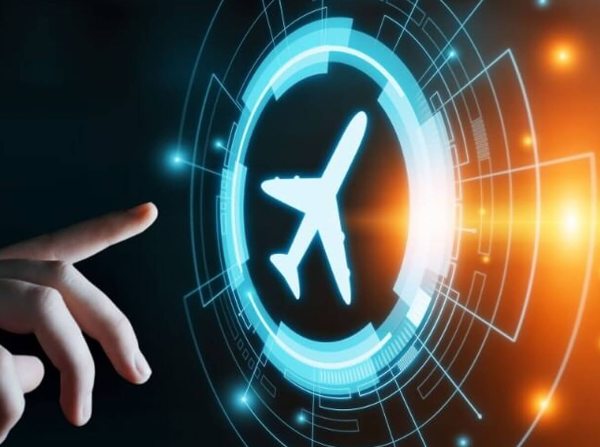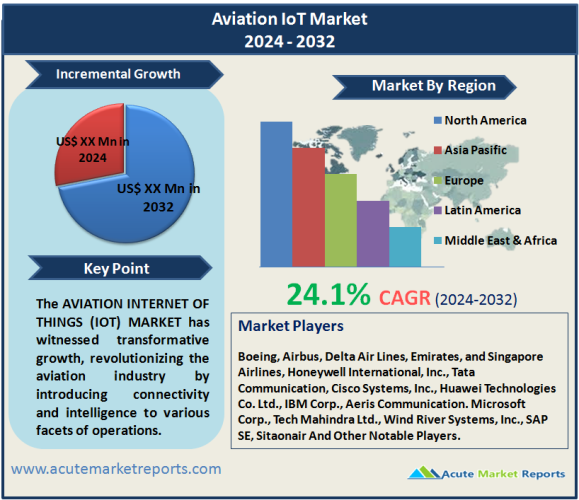
The aviation internet of things (IoT) market has witnessed transformative growth, revolutionizing the aviation industry by introducing connectivity and intelligence to various facets of operations. The aviation IoT market is expected to grow at a CAGR of 24.1% during the forecast period of 2025 to 2033, driven by the pursuit of safety, operational efficiency, and enhanced passenger experiences. While the challenge of cybersecurity remains, the industry is actively working towards robust solutions. The market dynamics vary across applications, end-use segments, and geographic regions, showcasing the adaptability and versatility of IoT in aviation. As major players continue to invest and innovate, the aviation IoT market is poised to play a pivotal role in shaping the future of aviation, offering smarter, safer, and more connected air travel experiences.
Enhanced Safety and Operational Efficiency
The paramount driver propelling the aviation IoT market is the relentless pursuit of enhanced safety and operational efficiency. Airlines and aviation stakeholders, including Boeing, Airbus, and major carriers, invested significantly in IoT solutions to monitor and analyze critical aircraft systems in real time. Evidence of this driver is evident in the industry's adoption of predictive maintenance, where IoT-enabled sensors on aircraft components anticipate potential failures, reducing unplanned downtime and enhancing overall safety.
Improved Passenger Experience and Connectivity
The demand for a seamless and connected passenger experience has been a significant driver in the aviation IoT market. Airlines such as Delta, Emirates, and Singapore Airlines have invested in IoT applications to provide passengers with enhanced in-flight connectivity, personalized services, and efficient navigation through airports. The evidence lies in the increasing prevalence of IoT-enabled in-flight entertainment systems, real-time flight updates, and smart airport infrastructure, contributing to an overall improvement in the passenger experience.

Optimized Ground Operations and Asset Management
IoT's impact on ground operations and asset management has been a key driver for the aviation industry. Ground handling services and airports globally, including Heathrow and Changi, have integrated IoT solutions to optimize baggage handling, aircraft refueling, and overall ground logistics. The evidence is reflected in the efficiency gains achieved through IoT-enabled asset tracking, reducing turnaround times for aircraft, and minimizing operational disruptions.
Restraint
Despite the positive momentum, a notable restraint in the aviation IoT market is the challenge of cybersecurity and data privacy. In 2024, as the industry embraced IoT, concerns emerged regarding the vulnerability of connected systems to cyber threats. Instances of data breaches, as evidenced by reports on attempted cyber-attacks on aviation systems, underscore the need for robust cybersecurity measures to safeguard critical flight and passenger data.
Market Segmentation by Application: Aircraft Operations Dominate the Market
The market can be segmented based on applications, including ground operations, passenger experience, aircraft operations, and asset management. In 2024, the highest revenue and CAGR were observed in the aircraft operations segment, driven by the extensive adoption of IoT in monitoring and optimizing flight systems. However, during the forecast period of 2025 to 2033, the highest CAGR is anticipated in the ground operations segment, reflecting the industry's continuous focus on enhancing efficiency on the ground.
Market Segmentation by End-Use - Airline Operators Dominate the Market
Segmenting the market by end-use includes the airport, airline operators, maintenance, repair, and overhaul (MRO), and aircraft original equipment manufacturers (OEMs). In 2024, the highest revenue was generated in the airline operators segment, as airlines invested in IoT solutions for operational improvements and passenger services. However, during the forecast period of 2025 to 2033, the highest CAGR is expected in the MRO segment, highlighting the growing importance of predictive maintenance and asset tracking.
North America Remains the Global Leader
Geographically, the aviation IoT market exhibited diverse trends. In 2024, North America led in both revenue and CAGR, driven by the presence of major aerospace companies and early IoT adoption. However, the Asia-Pacific region is expected to experience the highest CAGR during the forecast period, reflecting the increasing air travel demand and the implementation of IoT solutions in rapidly growing aviation markets.
Market Competition to Intensify during the Forecast Period
Top players in the aviation IoT market include Boeing, Airbus, Delta Air Lines, Emirates, Singapore Airlines, Honeywell International, Inc., Tata Communication, Cisco Systems, Inc., Huawei Technologies Co. Ltd., IBM Corp., Aeris Communication. Microsoft Corp., Tech Mahindra Ltd., Wind River Systems, Inc., SAP SE, Sitaonair. These companies deploy diverse strategies, including partnerships, acquisitions, and continuous innovation, to maintain their competitive edge. In 2024, their revenues reflected market leadership, with expectations of sustained growth during the forecast period.
Historical & Forecast Period
This study report represents analysis of each segment from 2023 to 2033 considering 2024 as the base year. Compounded Annual Growth Rate (CAGR) for each of the respective segments estimated for the forecast period of 2025 to 2033.
The current report comprises of quantitative market estimations for each micro market for every geographical region and qualitative market analysis such as micro and macro environment analysis, market trends, competitive intelligence, segment analysis, porters five force model, top winning strategies, top investment markets, emerging trends and technological analysis, case studies, strategic conclusions and recommendations and other key market insights.
Research Methodology
The complete research study was conducted in three phases, namely: secondary research, primary research, and expert panel review. key data point that enables the estimation of Aviation IoT market are as follows:
Market forecast was performed through proprietary software that analyzes various qualitative and quantitative factors. Growth rate and CAGR were estimated through intensive secondary and primary research. Data triangulation across various data points provides accuracy across various analyzed market segments in the report. Application of both top down and bottom-up approach for validation of market estimation assures logical, methodical and mathematical consistency of the quantitative data.
| ATTRIBUTE | DETAILS |
|---|---|
| Research Period | 2023-2033 |
| Base Year | 2024 |
| Forecast Period | 2025-2033 |
| Historical Year | 2023 |
| Unit | USD Million |
| Segmentation | |
Application
| |
Component
| |
End-Use
| |
|
Region Segment (2023-2033; US$ Million)
|
Key questions answered in this report